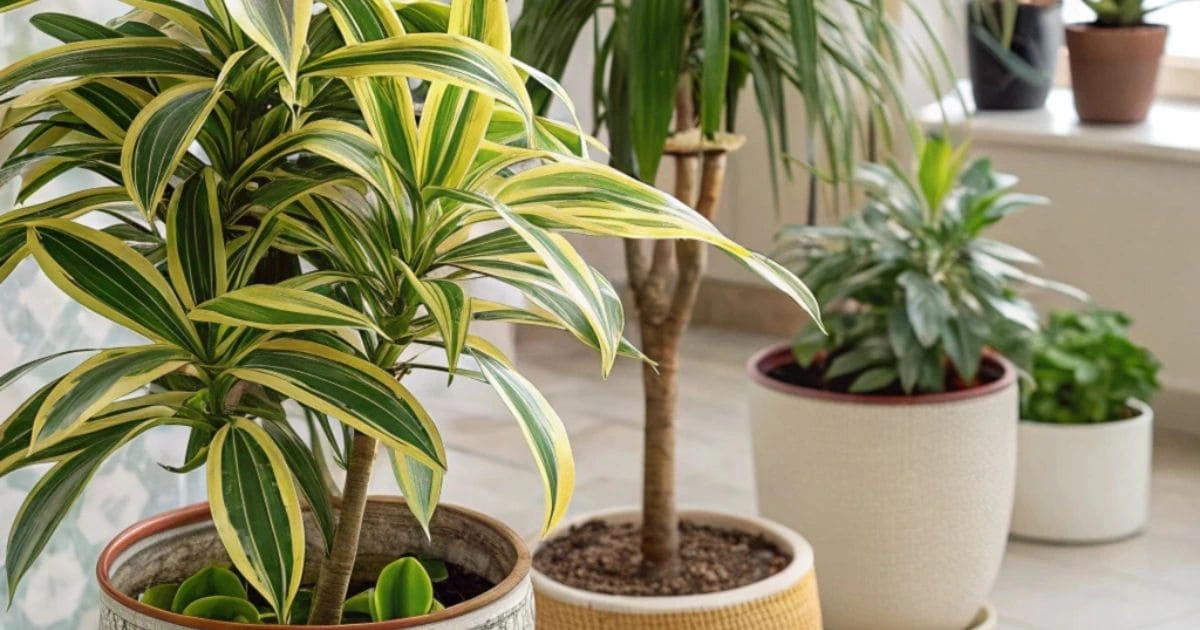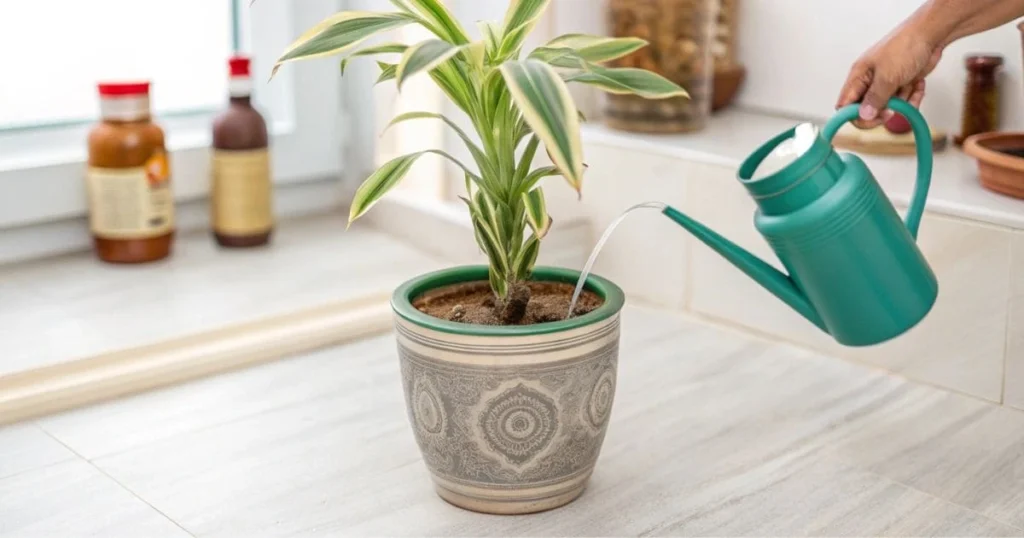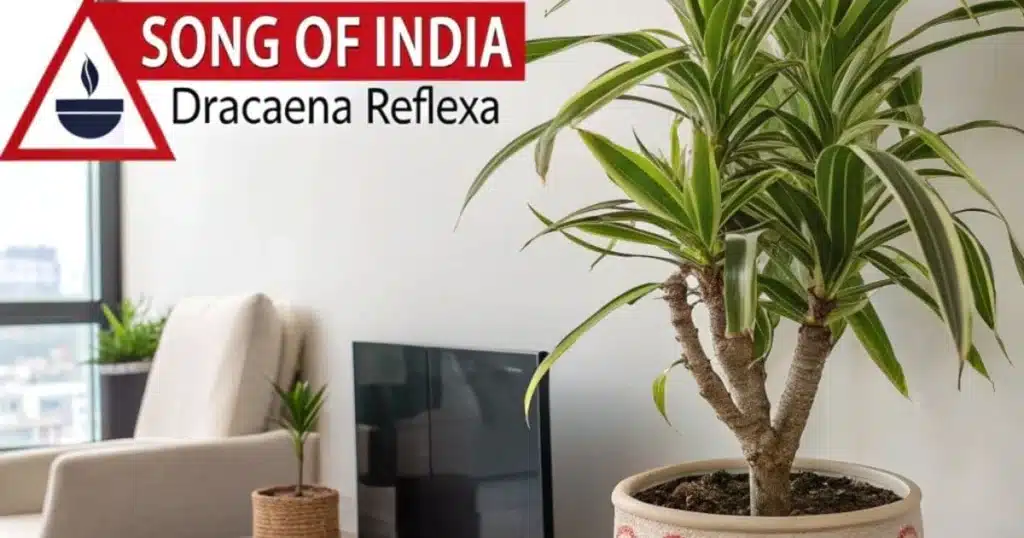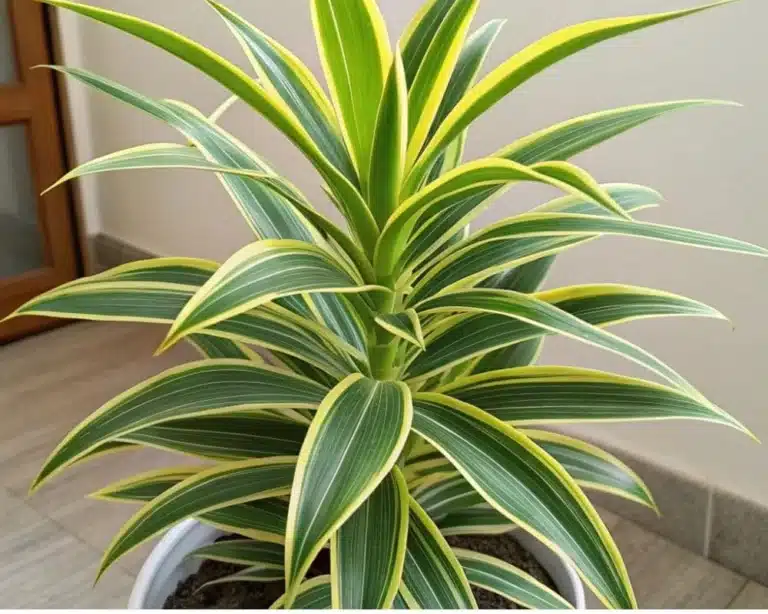The Song of India plant (Dracaena reflexa) is a striking, low-maintenance houseplant admired for its vibrant green and yellow-striped leaves. Known for its resilience and adaptability, this tropical beauty instantly elevates any space with its bold, architectural presence. Whether you’re looking to enhance your indoor décor or add a touch of greenery to your office, the Song of India plant delivers both style and simplicity.
This guide provides a professional, step-by-step approach to growing and caring for the Song of India plant, covering everything from optimal light conditions and watering routines to pruning techniques and pest management. With practical tips and proven methods, you’ll learn how to keep your plant thriving, healthy, and visually stunning all year round.
Let’s get started and discover how to transform your space with the exotic charm of the Song of India plant!
Table of Contents
Understanding the Song of India Plant
Origin and Native Habitat
The Song of India plant, scientifically known as Dracaena reflexa, is a tropical shrub native to the warm climates of the Indian Ocean, specifically Madagascar and other nearby islands. In its natural habitat, it can grow to impressive heights, towering over 20 feet. However, when cultivated indoors, it maintains a more manageable size, making it a popular choice for houseplant enthusiasts.
Botanical Characteristics
This plant is known for its striking foliage, featuring narrow, lanceolate leaves with alternating dark green and chartreuse stripes. These vibrant colors make it a standout addition to any indoor space. As a member of the Asparagaceae family, the Song of India shares its lineage with other well-known houseplants like the corn plant and dragon tree. Its unique appearance and adaptability make it a favored choice for indoor gardening.
Common Names and Varieties

The Song of India plant is also commonly referred to as “Song of Jamaica” or “Pleomele.” Within its species, several varieties exist, each with distinct leaf patterns and growth habits:
- Dracaena reflexa ‘Variegata’: This variety boasts bright lime-yellow leaf margins that contrast with the dark green center, creating a striking visual effect.
- Dracaena reflexa ‘Song of Jamaica’: Known for its unusual stem growth angles, this variant features off-white stripes instead of the typical chartreuse.
The Song of India is not just a plant but a symbol of resilience and adaptability, thriving in diverse conditions and adding a touch of tropical elegance to any setting.
When considering adding this plant to your collection, remember that it is a perennial shrub with a “survivor” personality, capable of withstanding various indoor environments. Whether you’re a seasoned gardener or a novice, the Song of India is a delightful and low-maintenance choice for any plant lover.
Optimal Growing Conditions for Song of India
Light Requirements
The Song of India, a tropical plant native to the Indian Ocean region, thrives in bright, indirect light. Aim for at least four hours of such light daily to keep the leaves vibrant. Direct sunlight, however, can scorch the leaves, so be cautious about placement. For those growing indoors, placing the plant near a south-facing window, but not directly in the sun, is ideal.
Temperature and Humidity
This plant prefers a consistent temperature range between 65°F and 75°F. Being native to the Indian Ocean’s warm climate, it doesn’t handle cold well. Avoid placing it near cold drafts or air conditioning vents. High humidity levels are also beneficial. You can increase humidity by placing a humidifier nearby or grouping it with other plants.
Soil and Potting Mix
The Song of India isn’t picky about soil but favors a well-draining mix. A combination of peat, perlite, and vermiculite works well. This ensures the roots don’t sit in water, which can lead to root rot. Consider repotting annually to refresh the soil, especially if you notice the plant’s growth slowing down. A good practice is to allow the top inch of soil to dry out between waterings.
Watering and Fertilizing Song of India

Watering Schedule and Techniques
The dracaena reflexa, commonly known as the Song of India, is a resilient ornamental plant that thrives best when its watering needs are met precisely. It’s crucial to keep the soil moist but not saturated. During the growing seasons of spring and summer, water the plant thoroughly, allowing the top inch of soil to dry out between waterings. In the cooler months, reduce the frequency, letting the soil dry out a bit more.
- Use room-temperature, fluoride-free water to prevent leaf damage.
- Ensure the pot has drainage holes to avoid waterlogging.
- Consider using a moisture meter to check soil moist levels accurately.
Signs of Overwatering and Underwatering
Overwatering can lead to root rot, a common issue with dracaena song plants. Look for yellowing leaves and mushy roots as indicators. Underwatering, on the other hand, will cause the leaves to dry and curl.
- Overwatering: Yellow leaves, soft stems, and a foul odor from the soil.
- Underwatering: Brown leaf tips, crispy edges, and drooping foliage.
Fertilizer Needs and Recommendations
Though the Song of India doesn’t demand much in terms of fertilization, providing balanced nutrients during its active growth phase can boost its health. Use a liquid fertilizer diluted to half-strength once a month during spring and summer. Avoid fertilizing in the fall and winter when the plant is dormant.
- Opt for a balanced 10-10-10 NPK fertilizer.
- Over-fertilization can lead to fusarium leaf spot, a fungal disease.
- If pests like spider mites appear, treat with insecticidal soap as a precaution.
Maintaining the right watering and feeding routine ensures your Song of India remains vibrant and healthy, adding a touch of green elegance to any space.
Pruning and Propagation Techniques
When and How to Prune
Pruning the Song of India plant isn’t something you’ll need to do all the time. This plant grows slowly, so it’s more about keeping it tidy or getting it ready for propagation. If you notice the stems getting too long or leggy, you can trim them back. Use sharp, clean pruners to make a cut just above a node—the spot where leaves emerge. New growth will eventually sprout from the top of the cut stems. Keep an eye out for any dead or damaged leaves and remove them too.
Propagation Methods
Propagating the Song of India is pretty straightforward. You can use stem cuttings, which should be about 6-12 inches long. Here’s a quick rundown of the steps:
- Cut just above a node.
- Place the cutting in water until roots are about 2 inches long, or plant it directly into a well-draining soil mix.
- Water the soil when it feels dry to the touch.
You can also use a mix designed for succulents or a seed-starting mix to help the cutting take root.
Encouraging Healthy Growth
To keep your plant thriving, it’s important to avoid root rot. Make sure your pot has good drainage, and don’t let the plant sit in water. Overwatering is a common issue, so let the soil dry out a bit between waterings. When you repot, use a soil mix that drains well, and consider adding some perlite or pumice to improve aeration.
Regular pruning and careful propagation can help ensure your Song of India stays healthy and vibrant. Just remember, keeping an eye on your watering habits is key to preventing root rot.
Common Problems and Solutions
Identifying Pests and Diseases
The Song of India plant, like many houseplants, can fall victim to various pests and diseases. Common pests include spider mites, mealybugs, and aphids. These tiny invaders can cause leaves to yellow and wilt. To tackle these pests, regularly inspect your plant and wipe the leaves with a damp cloth. For severe infestations, consider using insecticidal soap or neem oil.
Diseases in Song of India often stem from overwatering, leading to root rot. Ensure your plant is in well-draining soil and only water when the top inch of soil feels dry. Keeping a keen eye on your plant’s health can prevent many issues from escalating.
Troubleshooting Leaf Issues
Leaf problems in Song of India are usually a sign of environmental stress. Yellow leaves can indicate overwatering, while brown tips often suggest low humidity or fluoride sensitivity. Here’s a quick checklist to address leaf issues:
- Check the moisture level of the soil.
- Ensure the plant isn’t receiving direct sunlight, which can scorch the leaves.
- Adjust the humidity around the plant by misting or using a humidifier.
Preventing Root Rot
Root rot is a common issue for Song of India, primarily caused by excess water in the soil. To prevent this, make sure your pot has adequate drainage holes and use a well-draining potting mix. Avoid letting the plant sit in water, and always check the soil moisture before watering. If you suspect root rot, remove the plant from its pot, trim away any mushy roots, and repot in fresh soil.
Consistent care and attention to your Song of India’s environment will help it thrive and maintain its vibrant appearance.
Safety and Toxicity Concerns

Toxicity to Pets and Humans
The Song of India plant, while visually appealing with its dark green leaves, presents a moderate toxicity risk if ingested. This includes both pets and humans. It’s crucial to keep this plant out of reach from curious children and pets to prevent accidental ingestion. Symptoms of ingestion can include vomiting, drooling, and more severe digestive issues. If you suspect ingestion, contact Poison Control or a veterinarian immediately.
Safe Handling Practices
When handling the Song of India, it’s a good idea to wear gloves, especially if you have sensitive skin. The plant’s sap can cause mild irritation. Regular cleaning of the plant’s leaves with a damp cloth can prevent dust accumulation, ensuring the plant remains healthy and reduces the risk of accidental contact with the sap.
Emergency Measures
In the event of accidental ingestion, here are steps to follow:
- Identify the symptoms: Look for signs like vomiting or drooling.
- Limit further exposure: Move the plant to a safe location.
- Seek professional help: Contact Poison Control or a veterinarian.
Always err on the side of caution when dealing with plants that have any level of toxicity. Keeping your household safe involves awareness and proactive measures.
Seasonal Care and Maintenance
Adapting Care for Winter
As the temperature drops, the Song of India plant needs some special attention. This plant thrives best when kept away from cold drafts and sudden temperature changes. Keep it in a spot where the temperature remains steady, ideally between 60-75°F. If you notice brown leaf tips, it might be a sign of cold stress. Reduce watering during winter months, allowing the top inch of soil to dry out between waterings. This helps prevent root rot, a common issue when the plant sits in overly moist soil.
Repotting and Soil Refreshing
Spring is the perfect time to repot your Song of India. Choose a pot that’s one size larger to accommodate its growing roots. Use a well-draining potting mix to ensure excess water doesn’t linger. Refreshing the soil not only provides the plant with fresh nutrients but also helps in removing any pests like spider mite that might have settled in the old soil.
Preparing for Dormancy
Though not truly dormant, the Song of India slows its growth during the cooler months. This is a good time to cut back on fertilizing. Resume feeding in the spring to encourage new growth. Watch out for signs of stress, such as leaf spot, which can indicate poor air circulation or excessive moisture.
During seasonal transitions, it’s crucial to observe your plant’s needs closely. Adjusting care routines can significantly enhance its health and longevity.
Conclusion
Caring for the Song of India plant doesn’t have to be complicated. With the right amount of light, water, and a little attention to its environment, this plant can thrive in your home. Remember to keep it away from cold drafts and ensure it gets enough indirect sunlight. The soil should be well-draining, and watering should be adjusted based on the season. If you notice any issues, like yellowing leaves or drooping, a quick check of its care routine can usually set things right. With these simple steps, your Song of India can be a vibrant and healthy addition to your indoor garden.
To explore more about ornamental plant care, including tips on growing hosta and other plants, explore additional articles about ornamental gardening.
Frequently Asked Questions
How much sunlight does the Song of India plant need?
The Song of India plant thrives in bright, indirect sunlight for about four hours each day. Too much direct sunlight can harm the leaves.
What kind of soil is best for the Song of India plant?
A well-draining potting mix, preferably with peat, bark, pumice, vermiculite, and perlite, is ideal for the Song of India plant.
How often should I water the Song of India plant?
Water the plant enough to keep the soil moist but not soggy, reducing the frequency in winter. Let the soil dry a bit between waterings.
Is the Song of India plant safe for pets?
No, the Song of India plant is toxic to cats and dogs. It’s best to keep it out of reach of pets.
How can I propagate the Song of India plant?
You can propagate the Song of India by taking stem cuttings in spring. Place them in water or a peat and perlite mix until roots develop.
What should I do if my Song of India plant’s leaves turn brown?
Brown leaves can mean too much sun or water. Move the plant to a shadier spot or adjust watering. If leaves are red-tinged, it might be a disease.

